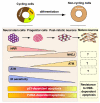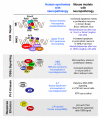Mouse models of DNA double-strand break repair and neurological disease
- PMID: 18458002
- PMCID: PMC3831504
- DOI: 10.1016/j.dnarep.2008.03.007
Mouse models of DNA double-strand break repair and neurological disease
Abstract
The repair of DNA damage is essential for the prevention of disease. The DNA double-strand break (DSB) is a particularly hazardous lesion. DNA DSBs activate a coordinated cellular response involving cell cycle checkpoint activation and repair of the DNA break, or alternatively apoptosis. In the nervous system the inability to respond to DNA DSBs may lead to neurodegenerative disease or brain tumors. Therefore, understanding the DNA DSB response mechanism in the nervous system is of high importance for developing new treatments for neurodegeneration and cancer. In this regard, the use of mouse models represents an important approach for advancing our understanding of the biology of the DNA damage response in the nervous system.
Figures


References
-
- Williams RW, Herrup K. The control of neuron number. Annu Rev Neurosci. 1988;11:423–453. - PubMed
-
- Katyal S, McKinnon PJ. DNA Repair Deficiency and Neurodegeneration. Cell Cycle. 2007;6 - PubMed
-
- McKinnon PJ, Caldecott KW. DNA Strand Break Repair and Human Genetic Disease. Annu Rev Genomics Hum Genet. 2007;8:37–55. - PubMed
-
- Rass U, Ahel I, West SC. Defective DNA repair and neurodegenerative disease. Cell. 2007;130:991–1004. - PubMed
-
- Cleaver JE. Cancer in xeroderma pigmentosum and related disorders of DNA repair. Nat Rev Cancer. 2005;5:564–573. - PubMed
Publication types
MeSH terms
Substances
Grants and funding
LinkOut - more resources
Full Text Sources
Medical

